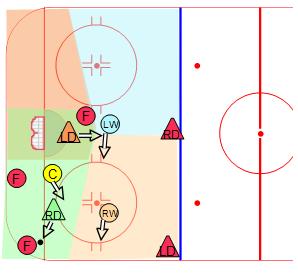“The system comes first. It is above superstars and it has to be followed to the letter…I believe that the best player on the team, no matter how talented he is, must conform to the system. I don’t like him to break away from the system – not even to score a goal. If he breaks away from the system, then everybody is going to break away from it.” – Flyers coach Fred Shero, 1975, ‘Shero: The Man Behind the System’
Evgeni Malkin was nowhere to be found.
This wasn’t a replay of Malkin’s dramatic escape from the claws of Russia, just another morning skate prior to another Penguins regular season game last week.
The team injury list already looked like an All-Star ballot: Crosby, Staal, Letang, Michalek. When coach Dan Bylsma said Malkin would be a game-time decision and refused to even offer the insightful phrases ‘upper-body injury’, ‘lower-body injury, or ‘maintenance day’, Penguins fans feared the worst.
Fortunately, a few hours later Malkin played against Detroit and put forth one of his best efforts of the season, looking stronger and faster than he has in years.
So Geno, why the game-time decision? An injury?
“No no, I feel good,” Malkin said after the game, “just……[coach] give me rest and I play tonight.”
Oh, okay?

A few sources hinted that Malkin may have gotten too much rest on Tuesday morning and the coaching staff was not thrilled with the assistant captain channeling his inner Tyler Seguin. True or not, the matter was handled internally — as it should be — and Malkin has responded with 11 points in four games since the incident.
Contrast that to Bruce Boudreau’s mismanagement of Alex Ovechkin. The Capitals star was seen questioning Boudreau’s ‘gut decision’ to sit him in a crucial late-game situation last month. Boudreau admitted he tried “every trick that he knew”, but nothing could relieve the weight of a disgruntled superstar owed $97 million over the next decade. After an eight-game stretch where Ovechkin scored just three points and looked generally disinterested, Boudreau was fired.
Perhaps Capitals GM George McPhee even foreshadowed Boudreau’s ultimate demise in these preseason comments to Chuck Gormley of CSN Philly:
For as long as the league has been around, there are a handful of guys who can make a difference and you really have to learn how to coach them. The rest, you open the door and they just go. It’s about teaching and coaching and showing the guys who can make a difference how to make a difference.
Bruce Boudreau won a Jack Adams Award in 2008 for turning around the Capitals as a rookie head coach. Dan Bylsma won the Jack Adams last year because he led the Penguins to regular season success despite a mountain of injuries. But the secret to longevity as an NHL head coach is finding a way to keep superstars happy on and off the ice within the boundaries of the team rules.
In the words of the legendary Fred Shero: The system must always come first.
______________________________________
Last year, critics of Evgeni Malkin blamed the Bylsma system as the reason for his struggles. They ignored Malkin’s lingering injuries, his attitude of indifference in the defensive zone, his lack of a legitimate scoring winger, or his soft-poke approach in the faceoff circle.
Instead, they saw scoring trophies and 100-point seasons under former coach Michel Therrien, but nothing in two full seasons under Dan Bylsma. They saw a group of Penguins forwards all hailing from North America and seemingly custom-built for Bylsma’s grind-it-out system, except for one: Evgeni Malkin.

As a center in Bylsma’s system, a player needs to be strong defensively and fast enough to join the rush after his teammates gain possession of the puck.
In the diagram to the right, the center (yellow dot) and two defensemen position themselves between opposing forwards and the net when the puck is in their own end. The system often breaks down when the center cheats up ice anticipating a turnover, leaving his man uncovered and his teammates scrambling to recover.
This has been Malkin’s biggest weakness.
He has the tendency to assume the puck is going to bounce his way in an effort to maximize offensive opportunities. When he guesses correctly, no one notices.
When he makes a mistake, the Penguins end up pinned in their own end or even worse, the puck ends up behind Marc-Andre Fleury:
Malkin (71) lets Matt Martin (17) float to the net alone not once, but twice in this October shift against the Islanders. Admittedly, Malkin was still getting his legs under him at this point in the season coming off major knee surgery, but the mistake is entirely mental and was a common occurrence in recent years.
But a few weeks ago something changed. Malkin started playing the relentless style of defense fans have come to expect out of shutdown center Jordan Staal. What sparked his sudden commitment to defense?
“It’s my job,” he said. “I play center, and sometimes I need to backcheck and not just forecheck.”
Malkin’s attention to detail has even allowed Bylsma to use him a different role, one that’s eased the burden typically placed on the Penguins’ other lines.
“Geno has been a force offensively,” said Bylsma. “He’s also a guy that we’re counting on to play against other team’s top lines and he’s been good at both ends of the rink. With him at center the last three weeks, he’s been going against other team’s best lines in a lot of cases.”
A look at the forwards Malkin has spent the most time against and his point production since Crosby has been out of the lineup tells a similar story:

On the offensive end of the ice, wingers like Steve Sullivan, Chris Kunitz, and James Neal have proven to be a big upgrade over last year’s duo of Matt Cooke and Max Talbot. Kunitz has become the relentless forechecking force he’s shown flashes of in the past but was never able to maintain over long stretches of time due to injuries. Neal continues to get open in the two areas of the ice he’s proven to have success and Malkin now knows where to find him.
But according to Dan Bylsma, Malkin himself is the reason he’s back in the NHL scoring race while also becoming an effective two-way forward:
I think there’s a lot to do with what Geno is doing this year that’s more than just who he is playing with. His determination coming into camp, his mindset, the confidence, the focus with which he’s playing.
We’re talking about a guy who didn’t want to really take a faceoff last year, and went out in a tough game [Tuesday night] and won 16 faceoffs. I think he was 16-and-7. To me, that’s just an indicator of him wanting to raise his level, him wanting to be in that spot, and him having another focus and gear to his game.
Malkin’s faceoff percentage of 45.4 percent this season isn’t all that impressive until you take into account his 38.5 percent success rate last year was better than just one player in the entire NHL who had attempted 200 or more draws (Patrick Dwyer).
In addition to his improvement in the faceoff circle, Malkin has also shown growth in other subtle parts of his game. Malkin is shooting and producing at career-high levels this season despite facing tougher matchups (QualComp) than previous seasons. He’s also become more patient with the puck, attempting wrist shots almost seven feet closer to the net than his monster seasons in 07-08 and 08-09.

Years ago, you could always find Malkin standing up on the bench waiting to get on the ice at the end of any game in which the Penguins had a multiple-goal lead. He wanted the empty-net goal to pad his stats.

Now Malkin says the points have become secondary. He knows the bounce of the puck can be tough to predict on a nightly basis, but there are other aspects of his game he can always control and his team and coach are relying on him to put in a consistent effort.
“I don’t think about points,” he said. “We win the game and I’m glad. Sometimes you have five points and of course that’s good but it’s not a big deal for me. I’m just trying to find my game. I lost a pretty long time with my knee and started a little bit slow. I feel a little bit better [now] and I’m just trying to find my level and continue to play better every game.”
Devastating injuries can tranform superstars into mere mortals. Malkin’s injury gave him a new perspective on the game he used to show up and offensively dominate at will. He committed himself to a grueling offseason conditioning program and has matured as a teammate within the demands of Bylsma’s system.
Because as Fred Shero said, the best player on the team, no matter how talented he is, must still conform to the system.
___________________________________________
I agree, this was a really well-written, insightful article. I’m very happy to see Malkin reaching this level again — he does seem to be more focused than ever before. He always cares and gets down on himself when he doesn’t play well, but he just seems to be taking a healthier approach in general.
Not surprised that Malkin slept in that morning — Allie guessed as much. I’m curious about how they dealt with it, but I’m glad we don’t know.
I really enjoy reading your articles Mike. Great work!